FI is the future and Husaberg has it nailed.
Husaberg has never been known for doing anything in a conventional fashion. The company was formed by the four-stroke believers who developed the first true modern four-stroke at Husqvarna when it was still a Swedish company. They took the thumper one step further with the first Husaberg and have continued pushing four-stroke development right into the current era with the machine's radical departure from convention and its 70-degree inclined engine configuration that further centers the mass of the motorcycle. Now they are refining it and becoming accepted, all the while continuing to remain unique.For 2011, the big news on the Berg is the fork. It goes from the open-cartridge WP design to a closed-cartridge system, the same fork the FX and KTM XCs run. Internally the settings were altered to keep the bike in the single-track/enduro performance realm with better damping control. The rear shock is set up to match the fork. Additionally the engineers gave the frame a small bracing in the head tube area to stiffen it up to get the fork to perform even better. From the 2009 machines the fork offset is pushed out from 19mm to 22mm to increase stability, and the FI system and mapping saw some minor tweaks as well. Then the mandatory graphics update about wraps it up for the 450, since the engine performance on that bike was never an issue.My ride on the new bike consisted of a day of setup and photos, plus a little trail riding, then right to the start line of the 2010 Jackpine National Enduro. I fit right on the box-stock bike with the bar set in the number two position and little else needed other than an adjustment of the ride height to about 108mm of rider sag. There the bike is right at 33mm of free sag, so my 185-pound frame does not quite demand going up on the spring rate. After some playing around in the Michigan sand I added a couple of extra clicks of compression and rebound on the shock and a couple clicks of compression on the fork. As has been the case, I didn't do a thing to the engine, though both a mellower and a more aggressive ignition setting were available if I'd wanted it through a Husaberg Powerparts optional switch. After a few hours of covering the clutch to carry second-gear speed in the tight trees during my dial-in ride, and knowing what the trails would be like for the next day's race, I managed to get my hands on a Rekluse Z-Start Pro automatic clutch, another goodie available through the Powerparts catalog.The "Husaberg feel" is that the bike is heavy when you are pushing or lifting it with the motor not running, but once you start riding the bike the weight really melts away compared to almost every other four-stroke out there. And as the rpm increase, where other four-strokes gain weight feel in a proportionate manner, the Husaberg stays lighter and more nimble in turning and side-to-side action. It is a perfect match of the long four-stroke power to be applied without the typical weight disadvantage a four-stroke gets in tighter, physically demanding conditions.And when you are using muscle to flick, fling and force the bar between trees when the bike would rather go straight, there isn't a 450cc four-stroke that has felt this good at dodging trees in all of my years of riding. (I've never been as confident in tapping the bark busters on trees as I was with this bike, but an extra half-inch off of the bar ends wouldn't have hurt, either!) The FE turns on the front wheel with the bike more inclined to follow that front wheel when you turn than most other bikes. It does it under power and on deceleration, and for some it can be a little much, giving a feeling of instability 'til you get used to the quick-steering and low effort required to sling through twisties.
FI is the future and Husaberg has it nailed.
The FE has 99 percent flawless FI performance; the 449cc single with 11.8:1 compression pulls from a lower rpm than seems possible with a very linear and progressive power delivery all the way to a top-end scream (or howl) out of the gas-tank area airbox that is music to the ears and exciting to the mind as trees begin to blur. Compared to a KTM 450 XC-W, the power builds quicker on the bottom and lasts longer on top, which for me is about perfect. The bike is quiet out of the muffler but talks to the rider through the airbox. The six-speed transmission is spaced just right without any large gaps. The hydraulic clutch will take abuse that would leave most bikes stranded trailside. And the addition of the Rekluse automatic clutch let me get away with murder, with nary a stall or worry when slamming the rear brake to get the bike turning in the trees. My FE only cough-stalled once during the enduro when it was scorching hot in some crazy on-off-on throttle application and did one backfire in similar conditions but didn't stall then.The upgraded fork was hard to evaluate for improvement compared to last year's design because the perfect sandy conditions were not that taxing on the front end in a lot of ways. But overall the suspension was excellent in everything from minor braking chop to the sections of OHV trail that were whooped out. The bike uses its stroke like it should but does not get huck-a-bucky like the 2009 could when being pushed hard. It is about as perfect of a single-track racing setup as one could expect and follows a very common feel that has kept the KTM XC-Ws a trail riding favorite; the FE fits in right between KTM's XC-W and defunct four-stroke XC.One part that survived the torture well was the brakes. Strong and progressive action had the rear reaching heat-induced squeaking and squealing, but it never went away or got overly grabby. The front is strong, too strong for some until they grew used to it, but that does not take long and any other brakes will then feel weak. The radiators took some hits, and the shrouds survived the tree scraping, though a pile drive into a tree got the better of the headlight in the first special test. The Berg never hinted at boiling, and this was while the clutch was being abused, a sure way to heat up a motor. The bike is thin and narrow (the visible bulge by the muffler isn't an issue unless your foot goes flying back off the peg), and for most riders the FE rewards a sit-down riding style, though riding standing is fine as well. Overall the FE is not as roomy as a KTM, even with the same adjustable-position top bar clamp.With a nice seventh place finish in the Senior 40+ A class and a trophy from the famous Jackpine Enduro to prove it, I don't think I could have had a better four-stroke to attack this race, arguably one of the tightest National Enduros on the circuit. But the biggest thing I noticed was that at the finish I was not at all as tired and fatigued as I am normally after a race like this, and that says a lot about how well the bike was working. So don't think a Husaberg is a strange or even oddball bike anymore. Husabergs are as proven as anything, with Dirt Rider Bike Of The Year performance and cutting-edge technology all refined into a package almost any rider will appreciate. The tighter the trail, the better this four-stroke shines, and the more trail you ride, the more this bike stands out from any competition.
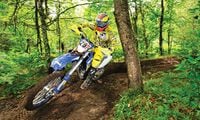
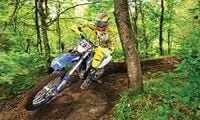
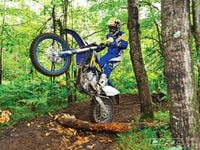
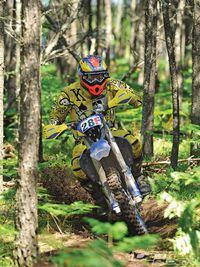
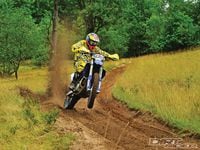
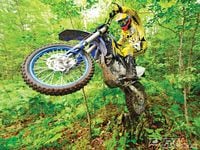
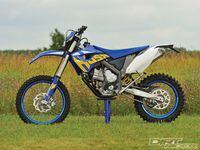
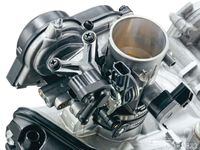
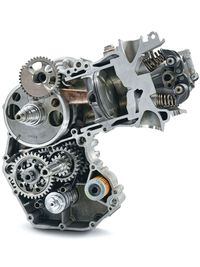
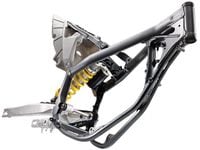
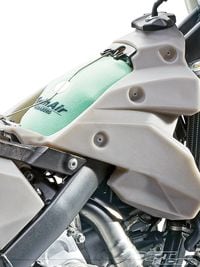
/cloudfront-us-east-1.images.arcpublishing.com/octane/RUNRR6IYQVA43JDR55ZMAOA7XA.jpg)
/cloudfront-us-east-1.images.arcpublishing.com/octane/SMVUQAKWYJHWDDTQTIUQQJO34Y.jpg)
/cloudfront-us-east-1.images.arcpublishing.com/octane/OWMGVFWC5ZF3RJ2XRWSIDF2NRI.jpg)
/cloudfront-us-east-1.images.arcpublishing.com/octane/KLZ25TVYZ5GY7BSXDQIVOHQMMI.jpg)
/cloudfront-us-east-1.images.arcpublishing.com/octane/HXQ2WUW6BRAPLBYPJEVJGD3OL4.jpg)
/cloudfront-us-east-1.images.arcpublishing.com/octane/ZPLKM2VALFFJJPQQA3N7RHMEJA.jpg)
/cloudfront-us-east-1.images.arcpublishing.com/octane/TR4IDUMUHRCD5FIQVSNDDRSHHE.jpg)
/cloudfront-us-east-1.images.arcpublishing.com/octane/OBJOWDJVVRHAXHAPZEUU3LGMOU.jpg)
/cloudfront-us-east-1.images.arcpublishing.com/octane/JOBKLRXU75BKXMWSQZIVL4ODYA.jpg)
/cloudfront-us-east-1.images.arcpublishing.com/octane/SSQSO7OLVZGUZKZJR2BENIUBJQ.jpg)
/cloudfront-us-east-1.images.arcpublishing.com/octane/LFOPBF4YG5EGBGO4BOEETVPWG4.jpg)
/cloudfront-us-east-1.images.arcpublishing.com/octane/7OT73ORBCBEPPO6SX5JQ7P5O44.jpg)
/cloudfront-us-east-1.images.arcpublishing.com/octane/LGTWINGMIVGLJB35IXQJCSK67A.jpg)
/cloudfront-us-east-1.images.arcpublishing.com/octane/F7QWUM4NZFDQ5CXBP3H5BQ33YY.jpg)
/cloudfront-us-east-1.images.arcpublishing.com/octane/3GCSEHNJBFFRTEOEKRYN5ZMYJM.jpg)
/cloudfront-us-east-1.images.arcpublishing.com/octane/6JJ3XIOJWBED5DQIAKUBNCLTZE.jpg)
/cloudfront-us-east-1.images.arcpublishing.com/octane/EXJM3ZOP5JGOFL2BNU2G6KCGX4.jpg)
/cloudfront-us-east-1.images.arcpublishing.com/octane/2VHGWMYT4RE33JOHF3ATQ4CWBY.jpg)
/cloudfront-us-east-1.images.arcpublishing.com/octane/MAA7CTOAVJEH5H5QNC45LBIHPM.jpg)
/cloudfront-us-east-1.images.arcpublishing.com/octane/NOJSQ77E2BHR3IMKEJPCENML4A.jpg)
/cloudfront-us-east-1.images.arcpublishing.com/octane/B5QDMPSPWRA3RBBQJUC4FNI4JI.jpg)
/cloudfront-us-east-1.images.arcpublishing.com/octane/B3BPW2WOCNCUZPL2QVICQUC4VU.jpg)
/cloudfront-us-east-1.images.arcpublishing.com/octane/MLFO3UACYFHHLLP7WUYGUCFCBI.jpg)
/cloudfront-us-east-1.images.arcpublishing.com/octane/RS3JKVKIG5H2TFBCQXCLFWSJ6Q.jpg)